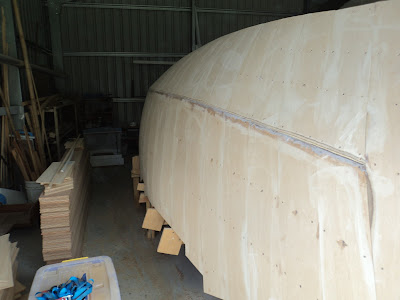Planking of the second layer continues. I will start with a few photo's of how I am fitting them. The planks are dry fit first then removed. Once you have done enough planks, generally about 8 to 13 I epoxy them in one session.
First you put epoxy/glue onto the hull:
Then onto the planks, I did two to three at a time. The red plastic scrapers to the left of the planks I use for spreading the epoxy. On the hull a flat one, on the planks I spoon the thickened mixture on then spread it with the larger one which has a series of notches cut into it. Disregard the thin one, it was too small so I went with two large ones.
The you screw it on and repeat. I found if you screw from the unplanked side towards the existing planks as you move across the screws it helps force epoxy across the plank and up through the gaps between the second layer planks. This should help eliminate hollow sections between the two layers.
End result on the first side half done:
And the other side. I did the epoxy of the entire length of the second side in one go but it was hard work over about four and a half hours. Make sure you get inside and scrape away the extra epoxy that is squeezed out on the inside joins as well otherwise you will have a lot of work to do when you flip it.
From the front:
And looking across at the transom:
Next step is to plane the chine join for the upper chine to overlap.
Thursday, 25 April 2013
Sunday, 14 April 2013
Second layer bow completed
After some minor sanding it was time to start the second layer. I decided to do the front where the full length planks are and move back from there. Firstly was the positioning of the first plank, which I lined up with the spot where the chine met the full length planks on the first layer but is placed on an angle toward the bow.
The process was the same as the first layer, but was a bit more effort as you can only clamp on the bottom and work your way up from there. Four full width planks with three screws per stringer, 9 more narrow ones with two screws each stringer and a large piece to finish (some will be cut away for the bowsprit after flipping).
Wasn't too bad, used the screw lines of the first layer to line up the second ones, only hit a couple and had to re-drill the holes. Did a full dry fit first each side prior to epoxy/glue, then pulled them all off. But make sure you run a pencil down the rear edge of the first plank and mark somewhere on the hull and plank to line it up. On each one I also put a pencil line across the join so I could line the planks up on final fit.
From the front:
Below is the first side:
And a series of shots to show how it has changed along the way:
Next step is the lower chine curve (as we look at it) both sides to the transom.
The process was the same as the first layer, but was a bit more effort as you can only clamp on the bottom and work your way up from there. Four full width planks with three screws per stringer, 9 more narrow ones with two screws each stringer and a large piece to finish (some will be cut away for the bowsprit after flipping).
Wasn't too bad, used the screw lines of the first layer to line up the second ones, only hit a couple and had to re-drill the holes. Did a full dry fit first each side prior to epoxy/glue, then pulled them all off. But make sure you run a pencil down the rear edge of the first plank and mark somewhere on the hull and plank to line it up. On each one I also put a pencil line across the join so I could line the planks up on final fit.
From the front:
Below is the first side:
And a series of shots to show how it has changed along the way:
Next step is the lower chine curve (as we look at it) both sides to the transom.
Thursday, 4 April 2013
Layer one done - prep for layer two
Managed to epoxy and screw on the remaining planks to finish the first layer. It looks exactly the same as the previous dry fit photos but I'm happy with that.
Prep for the second layer required the adjustment of the chine join for the second layer to overlap. First I used an electric plane and then a belt sander lightly to tidy up. I then went over both sides where a few plank joins were sitting up.
Below is the first side before, showing the overlap:
And after trimming the extra and sanding:
From further near the bow:
And after:
Looking from aft forward:
Below is a close up of the join. The second layer on the bottom is next which will overlap this join:
Other side:
Looking towards aft, the dark at the join is drying epoxy/glue where there was a small gap to fill:
And an overhead shot standing on top:
Onwards to the second layer.
Subscribe to:
Posts (Atom)



















